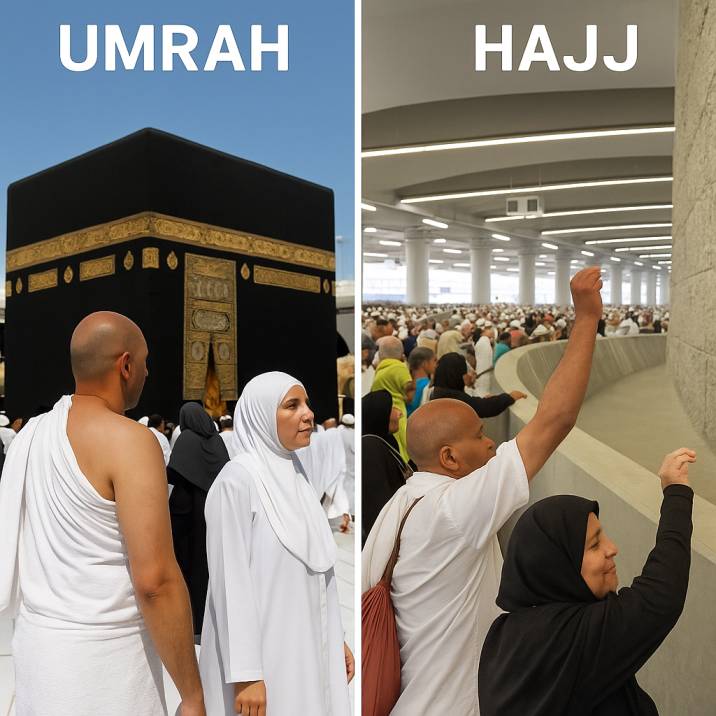Umrah vs. Hajj: What’s the Difference?

For Muslims around the world, both Umrah and Hajj are deeply spiritual journeys to the holy city of Makkah. While they share sacred destinations and some rituals, they differ greatly in terms of timing, obligation, rites performed, and spiritual context. Whether you’re preparing to fulfill one of the five pillars of Islam or seeking voluntary worship, it’s important to understand what sets these two pilgrimages apart.
In this guide, we break down everything you need to know about Umrah and Hajj to help you plan, prepare, and experience your pilgrimage with clarity and purpose.
1. Definitions and Religious Significance
What is Hajj?
Hajj is a mandatory religious duty for every Muslim who is physically and financially able to undertake it at least once in their lifetime. It is one of the five pillars of Islam and must be performed during a specific time in the Islamic lunar calendar—Dhul-Hijjah (8th to 12th).
What is Umrah?
Umrah is often referred to as the lesser pilgrimage. It is not obligatory but highly recommended (Sunnah). Unlike Hajj, Umrah can be performed at any time of the year and involves fewer rituals.
2. Timing
- Hajj can only be performed once a year, between the 8th and 12th of Dhul-Hijjah.
- Umrah can be performed any time, making it more flexible for planning and travel.
Because of the fixed timing, Hajj tends to attract millions of pilgrims at once, while Umrah has a more continuous but manageable flow throughout the year.
Stay Connected in Makkah
Use Voye Global’s eSIM for instant mobile data and spiritual tools during Hajj or Umrah.
3. Rituals Performed
Hajj Rituals:
Hajj is complex and includes the following:
- Entering Ihram from a designated Miqat
- Tawaf (circumambulation) around the Kaaba
- Sa’i (walking) between Safa and Marwah
- Spending a day in Arafat for the pivotal Wuquf
- Overnight stays in Mina and Muzdalifah
- Ramy al-Jamarat (stoning of the devil)
- Animal sacrifice (Qurbani)
- Shaving/cutting hair and Tawaf al-Ifadah
- Tawaf al-Wada (farewell circumambulation)
Umrah Rituals:
Umrah consists of four main actions:
- Entering Ihram
- Tawaf around the Kaaba
- Sa’i between Safa and Marwah
- Shaving or cutting the hair
There is no Arafat, Muzdalifah, Mina, or Qurbani in Umrah, making it a shorter and simpler ritual.
4. Duration
- Hajj generally takes 5 to 6 days.
- Umrah can be completed in a few hours to a full day, depending on crowd levels.
However, many pilgrims stay in Makkah or Madinah for additional days of worship, especially when combining Umrah with a longer visit
5. Obligation and Reward
- Hajj is obligatory once in a lifetime (for those eligible).
- Umrah is voluntary, though performing it multiple times is allowed and encouraged.
Both offer immense spiritual reward, but the status and weight of Hajj in Islam make it more significant.
No Roaming, No Worry
Enjoy 4G/5G data from arrival to departure with Voye Global eSIM—perfect for pilgrims.
6. Cost and Preparation
Hajj:
Due to the scale of the rituals, fixed timings, government quotas, and the need for logistics (accommodation in Mina, transportation, meals), Hajj is generally more expensive and complex to plan.
Umrah:
Much easier and less costly. You can book Umrah travel year-round and choose from various flexible packages that suit different budgets.
7. Spiritual Atmosphere
- Hajj is intense, communal, and filled with endurance. It reflects sacrifice, humility, and submission at a massive scale.
- Umrah is quieter, more personal, and offers time for private reflection and less physically demanding rituals.
Both allow pilgrims to connect deeply with Allah, cleanse their hearts, and renew their faith.
8. How to Stay Connected During Your Pilgrimage
No matter which pilgrimage you’re undertaking, staying connected is essential for navigation, communication with loved ones, group coordination, and spiritual tools (Quran apps, dua collections, and prayer time apps).
Choose Voye Global’s eSIM for Seamless Connectivity
Voye Global offers powerful, affordable eSIM solutions for Saudi Arabia.
Benefits of Using Voye:
- No SIM swap – just scan and activate
- Instant data on arrival in Makkah or Madinah
- Stay online for directions, group chats, and Hajj/Umrah apps
- Fast 4G/5G coverage across all pilgrimage zones
- Flexible data plans tailored for short or long stays
How to Use Voye eSIM:
- Visit voyeglobal.com and choose a Saudi Arabia eSIM plan
- Get your QR code instantly
- Open your phone’s mobile settings and scan to install
- Activate and stay connected throughout your journey
Whether you’re walking from Safa to Marwah or navigating the tents of Mina, Voye Global ensures that your digital and spiritual journey stays smooth.
Conclusion
While both Umrah and Hajj are acts of deep devotion, they cater to different needs and levels of obligation. Hajj is a once-in-a-lifetime pillar of Islam, demanding physical and spiritual endurance. Umrah, though voluntary, is no less special—a precious opportunity to draw closer to Allah at any time of year.
Whichever journey you embark on, preparation, understanding, and reliable support like Voye Global’s eSIM will ensure that your pilgrimage is spiritually meaningful and logistically stress-free.
May your journey be accepted, your sins forgiven, and your heart renewed.
Focus on Worship, Not Wi-Fi
Activate your Voye eSIM and stay online for navigation, Quran apps, and group contact.








